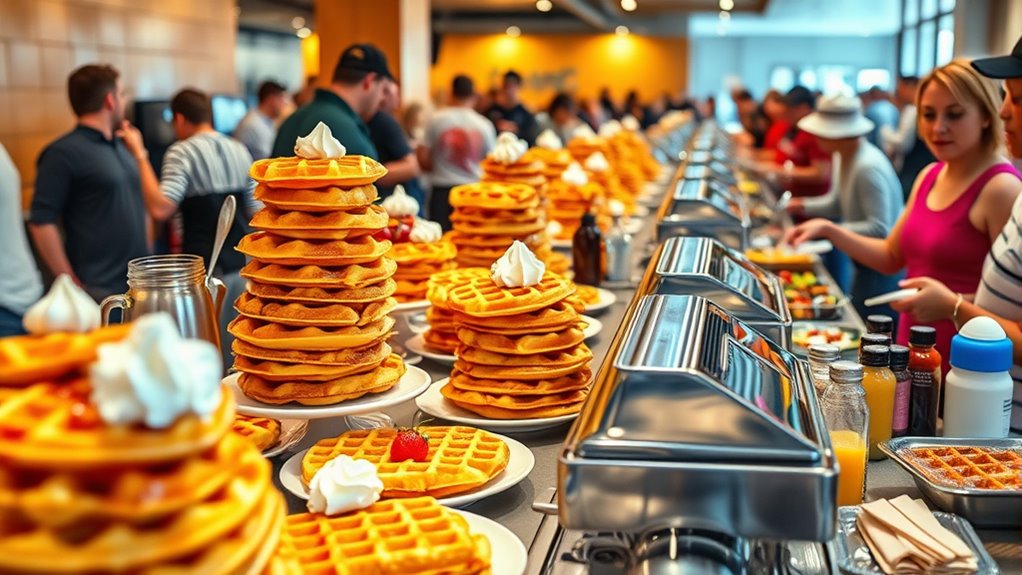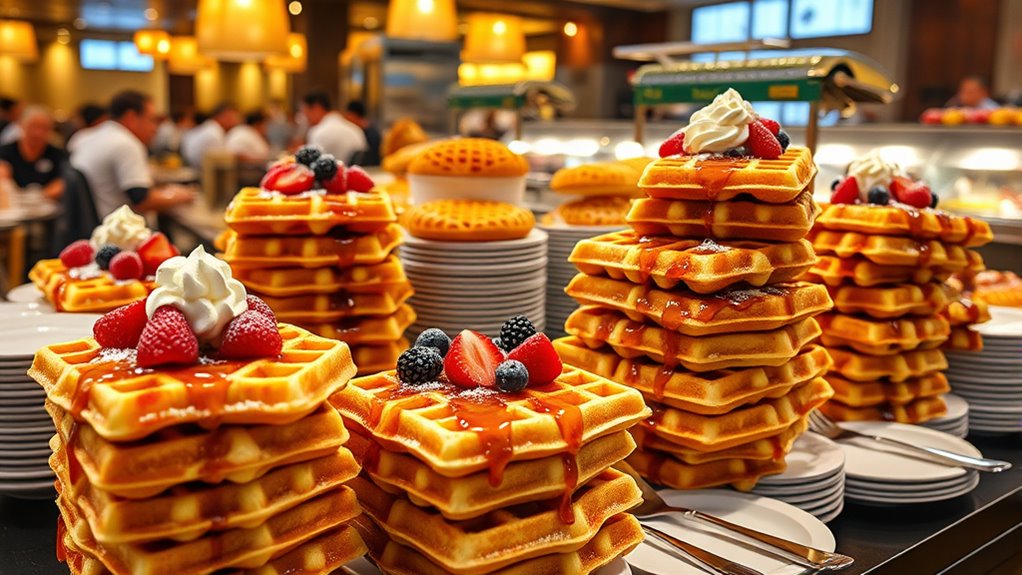All-you-can-eat waffle buffets rely on balancing customer satisfaction with strategic pricing and portion control. You’ll find that setting a flat rate encourages customers to indulge freely, but pricing often reflects typical consumption patterns to maximize revenue. Operators monitor how much people eat and their topping choices to adjust offers and prevent overstuffing. If you’re curious about how these strategies all work together to boost profit while keeping diners happy, there’s plenty more to explore.
Key Takeaways
- Pricing strategies balance between flat rates, consumption limits, and premium charges to maximize revenue and customer satisfaction.
- Consumer preferences and eating habits inform buffet setup, portion sizes, and pricing to optimize profitability.
- Perceived value influences customer behavior, with prices affecting intake, satisfaction, and overall revenue.
- Over- or underpricing can lead to reduced profitability by limiting consumption or encouraging overconsumption.
- Design Thinking and data analysis help buffet owners tailor offerings, pricing, and service to meet customer needs efficiently.

Waffle buffets have become a popular dining option, but behind their inviting appeal lies a complex economic dynamic. As a consumer, you might be drawn in by the idea of endless waffles and the promise of variety, but the success of these buffets hinges on carefully crafted pricing strategies. Owners analyze consumer behavior meticulously to determine the right price point that encourages you to indulge without overpaying or leaving money on the table. For instance, setting a flat rate for unlimited waffles encourages you to eat freely, but it also requires the business to predict how much you’ll consume. If you tend to eat more than the average, the pricing strategy might be designed to offset your higher consumption, ensuring profitability. Conversely, if most customers eat modest portions, the buffet might set a higher price to maximize revenue per guest while still attracting enough diners.
Your behavior influences how buffet operators structure their offerings. They observe whether you tend to sample a wide variety of toppings or stick to a few favorites, which impacts how they arrange their setup and price additional items. Some buffets include everything in a flat fee, banking on the idea that you’ll feel free to indulge without worrying about extra costs. Others might charge separately for premium toppings or specialty waffles, guiding your choices and managing overall expenses. By understanding your preferences and consumption patterns, owners can fine-tune their pricing to strike a balance—encouraging you to eat enough to enjoy the experience, but not so much that it becomes unprofitable.
Buffet owners adjust prices based on your topping choices and eating habits to balance enjoyment and profitability.
This dynamic is also influenced by consumer perceptions of value. If you believe the price reflects a fair deal for unlimited waffles and toppings, you’re more likely to indulge generously. However, if the cost seems too high, you might limit your intake or leave sooner, affecting the buffet’s revenue. Conversely, if the price feels too low, it might attract a rush of customers enthusiastic to get their money’s worth, but it could also lead to overconsumption that cuts into profits. This delicate balance requires buffet owners to analyze your consumer behavior carefully, adjusting prices and portions to maximize both your satisfaction and their bottom line.
Additionally, understanding the principles of Design Thinking can help owners innovate in creating more appealing and profitable buffet experiences by focusing on customer needs and iterating their offerings accordingly. By studying how much you eat, what you value, and how you respond to different price points, owners craft an experience that benefits everyone—delighting you with endless waffles while ensuring the business remains profitable. Behind the scenes, it’s a sophisticated dance of data, psychology, and economics that keeps these buffets thriving.
Frequently Asked Questions
How Do Waffle Buffet Prices Impact Customer Spending Habits?
You notice that waffle buffet prices directly influence your spending habits through pricing elasticity. When prices are lower, you’re more likely to indulge frequently, boosting your overall loyalty to the buffet. Conversely, higher prices may make you cautious, reducing your visits. As a result, pricing strategies can shape customer loyalty, encouraging repeat visits or deterring them based on how sensitive you are to price changes.
What Are the Key Factors Influencing Waffle Buffet Profitability?
Think of waffle buffet profitability like balancing on a tightrope—you need precision. Your key factors include setting effective pricing strategies that attract customers without hurting margins, and conducting competitor analysis to stay ahead. Controlling ingredient costs, managing portion sizes, and optimizing operational efficiency also matter. When you fine-tune these elements, you can boost profits while keeping guests satisfied and coming back for more.
How Do Supply Chain Costs Affect Waffle Buffet Pricing?
Supply chain costs directly influence waffle buffet pricing by affecting ingredient sourcing and distribution logistics. When sourcing ingredients, higher costs mean you might need to raise prices to maintain margins. Efficient distribution logistics can lower expenses, allowing you to offer more competitive prices. You should regularly evaluate your supply chain to identify cost-saving opportunities, ensuring your waffle buffet remains profitable while providing quality offerings to your customers.
What Role Does Consumer Behavior Play in Buffet Popularity?
You influence buffet popularity through your consumer psychology and dining preferences. When you seek variety and value, buffets become more attractive. Your expectations for quality, portion sizes, and ambiance shape your choices, encouraging others to follow suit. By sharing positive experiences or seeking specific features, you drive demand. Your behavior creates trends, making buffets more popular as they align with your desire for an enjoyable, cost-effective dining experience.
How Do Seasonal Trends Influence Waffle Buffet Demand?
Seasonal fluctuations considerably impact waffle buffet demand, as you’ll notice increased visits during holidays and colder months. You’re more likely to indulge when holiday promotions are offered, boosting popularity. These trends encourage buffet operators to adjust their marketing and menu offerings accordingly. Understanding seasonal patterns helps you plan your visits better, making sure you catch those special promotions and enjoy waffles when demand is at its peak.
Conclusion
As you savor that last, golden bite, you realize waffle buffets are like a bustling marketplace—full of endless options and hidden costs. Just like a tightrope walker balances risk and reward, you navigate the delicious maze of choices, knowing every fluffy bite has its price. So next time you indulge, remember—you’re part of an intricate dance between supply, demand, and your own appetite, weaving a tasty tapestry that leaves you both satisfied and savvy.









